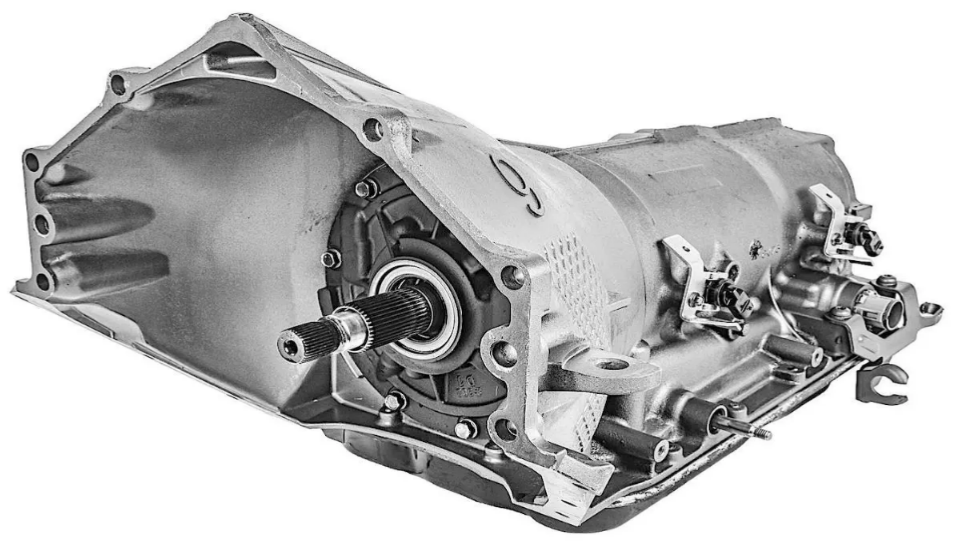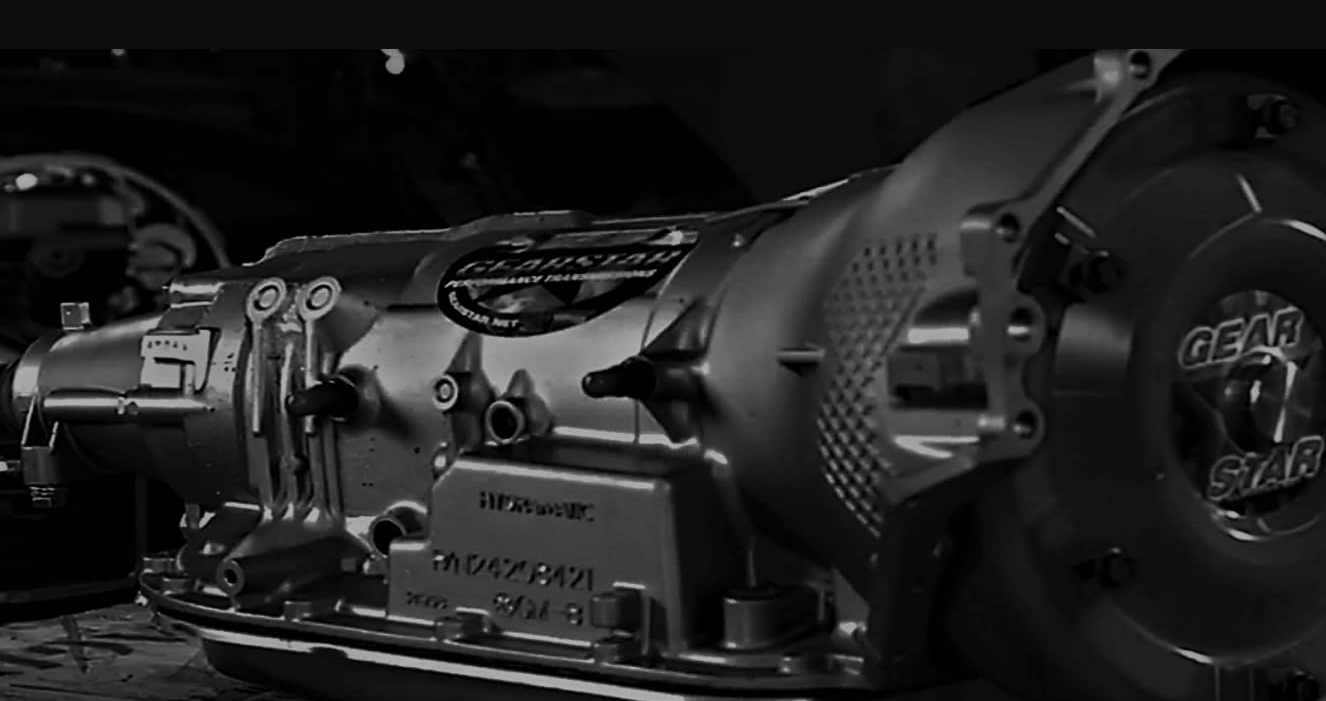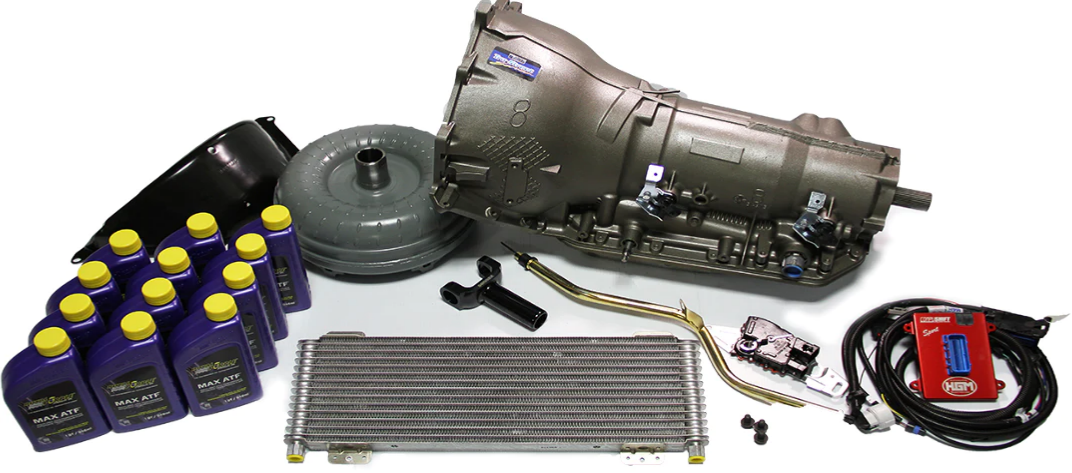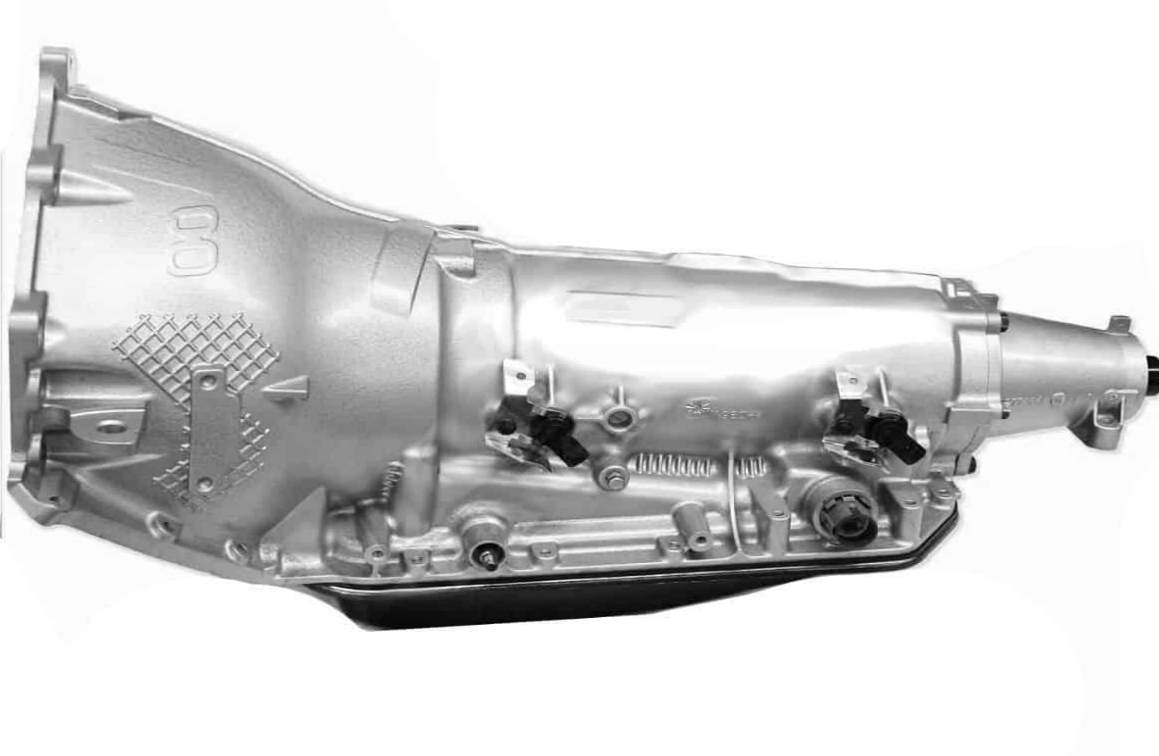The 4L80E transmission is a popular choice for many Chevrolet and GMC trucks and SUVs, especially those from the 1990s and 2000s.
Design and Features of the 4L80E Transmission
The 4L80E transmission, a brainchild of General Motors, is a marvel in the automotive world. Renowned for its durability and performance, this transmission has been a choice for many vehicle enthusiasts and professional applications.

Technical Specifications
- Type: Full Automatic, 4-Speed Overdrive
- Case Material: Cast Iron
- Maximum Engine Power: 440 lb-ft of torque
- Dimensions:
- Length: 26.4 inches
- Width: 19.8 inches
- Height: 22.3 inches
- Weight: Approximately 236 lbs
- Gear Ratios:
- 1st: 2.48
- 2nd: 1.48
- 3rd: 1.00
- 4th: 0.75
- Fluid Type: DEXRON VI Automatic Transmission Fluid
- Fluid Capacity: 13.5 quarts (dry fill)
Advantages and Disadvantages
Advantages:
- Durability: Crafted from high-quality materials, the 4L80E boasts a longer lifespan than many of its counterparts. It can typically last up to 150,000 miles before requiring significant maintenance, depending on usage.
- Power Handling: With its capability to handle up to 440 lb-ft of torque, this transmission is ideal for vehicles demanding higher power.
- Versatility: Due to its adaptive shift logic, the 4L80E provides a smooth driving experience, whether you’re in city traffic or cruising on highways.
- Efficiency: When maintained properly, this transmission offers an efficiency rate of 94%, ensuring better fuel consumption for vehicles.
Disadvantages:
- Weight: Weighing around 236 lbs, the 4L80E is heavier than some modern transmissions. This might slightly impact the vehicle’s overall efficiency and speed.
- Cost: The average cost for a brand-new 4L80E transmission can range between $2,000 to $2,500. Depending on the source and the warranty, this might be considered expensive for some budgets.
- Size: Its larger dimensions can make it a challenging fit for some vehicle configurations without modifications.
In conclusion, while the 4L80E transmission has its set of challenges, its advantages in durability, power handling, and versatility make it a preferred choice for many automotive enthusiasts and professionals.
Vehicles Equipped with the 4L80E Transmission
The 4L80E transmission, hailing from the stables of General Motors, has been a mainstay in a variety of vehicles over the years. Its versatility and robust nature have made it a favorite among many car manufacturers, not just GM. Let’s delve deeper into which vehicles were blessed with this engineering masterpiece.
General Motors (GM) Vehicles
From trucks to large sedans, General Motors has incorporated the 4L80E into a range of their products. Some notable mentions include:
- Chevrolet Suburban: A beast on wheels, the Suburban from the 1990s and early 2000s utilized the 4L80E for its optimal power distribution.
- Chevrolet Silverado 2500 and 3500: Both these trucks, known for their towing capacity, trusted the 4L80E for its torque handling prowess.
- GMC Sierra 2500 and 3500: Much like their Chevy counterparts, these GMC trucks employed the 4L80E to handle heavy loads and rough terrains.
- Chevrolet Express Vans: These vans, popular for transporting goods and people, leveraged the 4L80E’s reliability.
Aftermarket Adaptations for Non-GM Vehicles
Given the reputation of the 4L80E, aftermarket adaptations for non-GM vehicles became quite common. Many off-road enthusiasts, hot rodders, and racers adapted this transmission into their non-GM projects, including:
- Jeep Wrangler: For those pushing their Jeeps to the limit, the 4L80E provided the necessary durability.
- Ford Bronco: Off-road aficionados often switch out the stock transmission for a 4L80E to tackle challenging terrains.
It’s important to note that adapting the 4L80E into non-GM vehicles often requires specific aftermarket kits and modifications to ensure compatibility.
Popular Models and Their Variants
The 4L80E wasn’t restricted to just a few models. Over time, several variants emerged catering to different vehicle needs:
- 4L80E: The original version, introduced in 1991, was built for larger rear-wheel-drive cars and trucks.
- 4L85E: Introduced later, this variant was similar but fortified to handle more torque – up to 460 lb-ft.
Both versions are revered for their quality and performance, solidifying the 4L80E family’s place in automotive history.
In conclusion, the 4L80E transmission’s universal appeal, bolstered by its technical superiority, has made it a sought-after choice across a broad spectrum of vehicles – from daily commuters to off-road beasts.

Comparison with Other Transmissions
The automotive world is rife with competition, and transmissions are no exception. The 4L80E, with its sturdy design and reliable performance, often finds itself compared to its siblings and competitors. Let’s evaluate how it stands in such comparisons.
4L80E vs. 4L60E
The 4L80E and 4L60E are both automatic transmissions produced by General Motors. However, there are some stark differences:
- Torque Handling:
- 4L80E: Can handle up to 440 lb-ft of torque.
- 4L60E: Built for lighter-duty vehicles, it handles up to 360 lb-ft of torque.
- Dimensions and Weight:
- 4L80E: Heavier and larger, designed for trucks and larger vehicles.
- 4L60E: Lighter and more compact, making it suitable for passenger cars and smaller trucks.
- Construction Material:
- 4L80E: Comes with a cast-iron case, which ensures durability.
- 4L60E: Features an aluminum case, contributing to its lighter weight.
- Application:
- 4L80E: Generally found in larger trucks, vans, and SUVs.
- 4L60E: Often seen in passenger cars, smaller SUVs, and light trucks.
- Cost:
- 4L80E: Due to its beefier construction, it tends to be more expensive, often ranging between $2,000 to $2,500.
- 4L60E: Typically comes at a lower cost, with prices ranging from $1,200 to $1,800.
4L80E vs. Other Competing Transmissions
The 4L80E doesn’t just compete with its sibling. Here’s how it fares against other market contenders:
- Ford E4OD:
- This transmission by Ford is similar in strength to the 4L80E and was used in trucks like the F250 and F350.
- However, the 4L80E generally boasts a smoother shift pattern and is sometimes considered more durable because of its cast-iron construction.
- In terms of price, the E4OD can be slightly more expensive, depending on the model and application.
- Chrysler 46RH:
- Used predominantly in Dodge trucks, the 46RH is another contender.
- While it offers robust performance, the 4L80E generally has an edge in terms of efficiency and smoother power delivery.
- The 46RH, being an older design, might not offer the same level of modern refinement as the 4L80E.
In summation, while the 4L80E faces stiff competition from both its sibling and rivals, its unique combination of power handling, durability, and efficiency ensures that it remains a favorite in many automotive circles.
Common Problems and Solutions
Like all mechanical components, the 4L80E transmission isn’t without its set of problems. Fortunately, many of these issues have well-established solutions. Understanding the symptoms and acting promptly can save a vehicle owner time, stress, and money.
Recognizing Symptoms of 4L80E Transmission Issues
- Slipping Gears: If the 4L80E transmission starts slipping in and out of gears while driving, it could indicate a problem with the transmission fluid. Low or contaminated fluid can hamper the transmission’s operation.
- Delayed or Hard Shifts: This symptom often manifests as the transmission hesitating before changing gears. The cause could range from a failing shift solenoid to a worn clutch.
- Overheating: Transmissions can overheat for several reasons, but a common culprit in the 4L80E is often clogged or dirty transmission fluid. Overheating can be identified by a burning smell or the transmission warning light illuminating.
- Erratic Behavior: If the transmission behaves erratically, such as random hard shifts or refusing to shift, the transmission’s electronic components might be at fault.
- Fluid Leaks: Puddles or spots under the vehicle could indicate a leak. Common areas include the transmission pan gasket or the seals.
Maintenance and Repair Recommendations
- Regular Fluid Checks: Ensure the transmission fluid is at the right level and is clean. Dirty or low fluid can lead to several problems. Regular changes, approximately every 30,000 miles, can prevent many issues.
- Replace Faulty Solenoids: Solenoids control the flow of fluid throughout the transmission. If they malfunction, they can lead to hard or erratic shifts. Replacing them can resolve these issues and is typically more cost-effective than replacing the entire transmission.
- Upgrade Cooling Systems: One way to prevent overheating is to upgrade the transmission cooler. A more efficient cooling system can help maintain optimal transmission temperatures, especially in demanding conditions.
- Seal and Gasket Maintenance: Regularly inspecting and replacing worn seals and gaskets can prevent leaks, ensuring that the transmission operates with the necessary fluid levels.
- Electronic Component Check: The 4L80E is electronically controlled. Periodic checks of its electronic components, including sensors and the Transmission Control Module (TCM), can prevent erratic behavior.
- Professional Diagnosis: If you notice any symptoms or if the transmission doesn’t feel right, it’s always recommended to seek a professional diagnosis. A transmission specialist can identify issues early on, potentially saving significant repair costs in the long run.
In conclusion, while the 4L80E transmission is robust and reliable, it’s not immune to problems. Recognizing symptoms early and adhering to maintenance recommendations can ensure its long and efficient service life.

Upgrades and Performance Improvements
Automobile enthusiasts and those seeking enhanced performance often turn their eyes towards upgrades. The 4L80E transmission, with its impressive baseline performance, offers a plethora of opportunities for enhancements. Dive deep into the world of upgrading the 4L80E, exploring aftermarket kits and understanding the tangible benefits of these modifications.
Aftermarket Kits and Components
- Shift Kits: Shift kits are designed to make gear transitions smoother and more efficient. Brands like TransGo offer kits that can provide faster shifts, potentially reducing wear and enhancing speed.
- Performance Torque Converters: High-performance torque converters can handle higher levels of torque and horsepower. Companies like Hughes Performance and Precision Industries provide torque converters that can handle over 1000 lb-ft of torque.
- Heavy Duty Clutches: Reinforced clutches can withstand higher power levels, ensuring longevity even under demanding conditions. These clutches might cost around $400 to $600, depending on the brand and specifications.
- Deep Transmission Pans: These pans have a larger capacity, which means they can hold more transmission fluid. This not only aids in better cooling but also extends the fluid’s life. Pans like these are available in the price range of $150 to $250.
- Electronics and Controllers: Upgraded electronic controllers can fine-tune the transmission’s behavior, tailoring its performance to specific driving needs.
Benefits of Upgrading the 4L80E Transmission
- Increased Durability: Aftermarket components are often made from high-quality materials designed to withstand challenging conditions, thus extending the transmission’s lifespan.
- Enhanced Performance: Upgrades can result in quicker shifts, increased torque handling, and more responsive performance. This can shave off crucial seconds in racing or towing scenarios.
- Customizability: Upgrades allow car enthusiasts to tailor the transmission’s behavior to their specific needs, be it for racing, heavy-duty towing, or off-roading.
- Value Addition: A well-maintained and upgraded 4L80E can increase the overall value of the vehicle, especially in niche markets where specific performance metrics are sought after.
- Cost Savings: While there’s an initial outlay for upgrades, in the long run, enhanced components can reduce wear and tear, potentially saving on maintenance and replacement costs.
In a nutshell, upgrading the 4L80E transmission not only boosts its performance but can also offer long-term benefits in terms of durability and cost savings. Whether you’re a performance enthusiast or someone looking to enhance your vehicle’s capabilities, the 4L80E offers a strong foundation to build upon.

